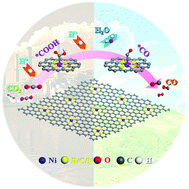Coordination environment engineering on nickel single-atom catalysts for CO2 electroreduction†
Abstract
Coordination engineering has recently emerged as a promising strategy to boost the activity of single atom catalysts (SACs) in electrocatalytic CO2 reduction reactions (CO2RR). Understanding the correlation between activity/selectivity and the coordination environment would enable the rational design of more advanced SACs for CO2 reduction. Herein, via density functional theory (DFT) computations, we systematically studied the effects of coordination environment regulation on the CO2RR activity of Ni SACs on C, N, or B co-doped graphene. The results reveal that the coordination environments can strongly affect the adsorption and reaction characteristics. In the C and/or N coordinated Ni–BXCYNZ (B-free, X = 0), only Ni acts as the active site. While in the B, C and/or N coordinated Ni–BXCYNZ (X ≠ 0), the B has transition-metal-like properties, where B and Ni function as dual-site active centers and concertedly tune the adsorption of CO2RR intermediates. The tunability in the adsorption modes and strengths also results in a weakened linear scaling relationship between *COOH and *CO and causes a significant activity difference. The CO2RR activity and the adsorption energy of *COOH/*CO are correlated to construct a volcano-type activity plot. Most of the B, C, and/or N-coordinated Ni–BXCYNZ (X ≠ 0) are located in the left region where *CO desorption is the most difficult step, while the C and/or N coordinated Ni–BXCYNZ (X = 0) are located in the right region where *COOH formation is the potential-determining step. Among all the possible Ni–BXCYNZ candidates, Ni–B0C3N1 and Ni–B1C1N2-N-oppo are predicted to be the most active and selective catalysts for the CO2RR. Our findings provide insightful guidance for developing highly effective CO2RR catalysts based on a codoped coordination environment.

- This article is part of the themed collections: Celebrating International Women’s Day: Women in Nanoscience, Nanoscale 2022 Emerging Investigators, Nanoscale 2022 Lunar New Year Collection and Nanoscale Most Popular 2021 Articles


 Please wait while we load your content...
Please wait while we load your content...